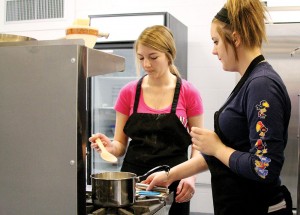Every morning at 7:45, junior Alex Torres rushes to drop her sister off at school so she won’t be too late to her first hour class at Holcom Park.
Torres is one of six students who participate in a Culinary II class at the Career Community Connections Center located at the park.
“Culinary II is for those students who intend to follow a career in hospitality and tourism,” curriculum specialist Rick Henry said. “Students will practice culinary skills and develop knowledge of dining room management.”
Because of demand for an upper-level class, Culinary II was implemented in the spring semester.
“There was a huge demand for it and career prospects are good for students taking these courses,” Henry said.
The goal of the course is to prepare students for the future.
“It will help them obtain employment or provide a foundation for continued education at a college or technical school,” Henry said.
Culinary II is senior Stephen Wampler’s first step in this direction.
“The teacher (Sandra Lawson) actually talked me into going into hotel and restaurant management,” Wampler said. “So I can go there, and I can cook and make a living off of that.”
For culinary teacher Sandra Lawson, preparing students to take that step is her ultimate goal.
“It prepares kids for the post-secondary schools, and it gives them training,” Lawson said. “Even if they go to a full year college, for instance, for a business major, they have the skills and they can go and work in the back of the house of a restaurant or the front of the house and pull some decent wages because they have some experience.”
However, most students in the class use it as practice for when they leave home.
“We’ve learned a lot of recipes that I’ll end up using later on in life [and] when I move out on my own,” senior Morgan Mattan said.
Over the semester, students have learned how to make various soups, sauces and pasta.
“We cut a lot of vegetables, [we] spent almost a month on vegetables,” Torres said.
At first, it was hard for the class to do much since they were running low on supplies.
“We went like a month and a half without any pots or pans,” Mattan said. “[Lawson] was bringing her stuff from home.”
But before students can even touch these supplies, they have to be qualified.
“There is a sequence of classes they need to take to prepare them for the higher skilled classes,” LHS family and consumer science teacher Shannon Wilson said.
The requirements and location of the class have caused enrollment to be low with only six students from Free State and LHS combined. However, the small class size is sometimes an advantage.
“Because it’s smaller we do a lot more, we have a lot more time to do things, and we do labs more often than at the high school,” Mattan said.
But Mattan still hopes to see it grow in the future.
“I hope they figure out another way to have more classes other than just one class because there can’t be very many students here,” Mattan said.
The recent passing of the bond in USD 497 may help the class do this.
“I can see tremendous growth potential in this area — if this growth occurs, expansion of the program will be necessary,” Henry said.
Even without the bond issue, Wilson said the implementation of more classes is still the goal.
“We like to think we can offer something for all students so I expect that as the need arises we will be able to accommodate other interests,” Wilson said.



